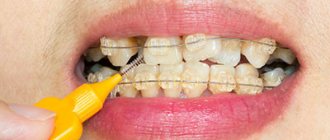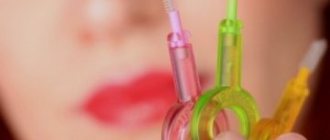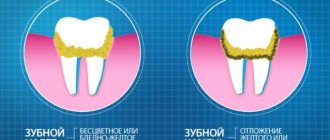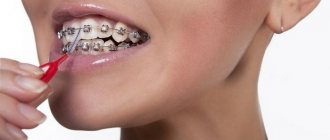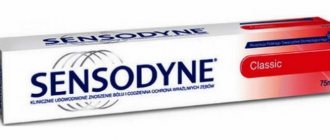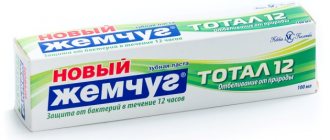Every person uses toothpaste and a brush to brush their teeth every day. Some of us floss. But not everyone has even heard of a dental brush. This oral hygiene tool helps to better clean teeth from plaque and food debris in hard-to-reach areas. What is a dental brush, in what cases is it necessary, and how to use it correctly?
What is a toothbrush?
For reference! The appearance of such a product for the oral cavity is similar to a regular brush used for cleaning glass containers, but its size is several times smaller.
two components in this device :
- pen;
- The product itself is a brush, which is used to clean the surface between the teeth.
The length of the bristly rod reaches several centimeters.
Its basis is a steel wire on which synthetic bristles are attached.
They are most often made from nylon, although other synthetic materials are also used.
The rod is additionally covered with plastic. This was done to prevent the occurrence of static discharges during use of the device.
Note! The materials used in the manufacturing process of these products are always environmentally friendly, durable and inert.
Thus, they do not enter into oxidation processes upon contact with saliva during the procedure.
Depending on the manufacturer, these devices are available both as attachments and as a one-piece design. The first ones come with special holders.
Why are such interdental products needed?
The purpose of these interdental products is to remove dirt between teeth and in hard-to-reach places (in the case of installed braces).
Thanks to high-quality cleaning of the dental cavity using a brush, the risk of caries and periodontal disease is reduced, bad breath and bleeding gums are eliminated .
The lateral surface of the teeth makes up 40% of the entire dental surface.
It is difficult to clean dirt from these areas with a regular brush, but it is between the teeth that putrefactive bacteria develop most actively.
Operating principle
Using a brush, the surface of the tooth is cleaned - on each side at different angles. This is the difference between a toothbrush and a brush. The soft fibers of the product penetrate even into the narrow interdental space. With the help of light movements, the surface is cleaned, you can get rid of food residues and plaque.
Cleaners vary in size and hardness. Depending on this, even getting rid of tartar is allowed. True, it will take more time than simply cleaning every day.
Indications for use
It is worth noting! As for the indications for the use of interdental brushes, it is advisable to use this product along with a regular toothbrush and, after basic cleaning, clean with this simple device.
The use of tooth enamel brushes especially recommended for the following categories of people:
- patients with installed dental implants , as well as devices for aligning the bite, for example, braces. Using a toothbrush, it is impossible to remove all plaque and food debris from small parts and elements of braces, bridges or implants. The brush, due to its size, is able to penetrate even the smallest holes and crevices;
- those on their tooth enamel from drinking coffee, tea or smoking
- there is a need to carry out a daily light massage of the gums and clean them ;
- those who suffer from malocclusion but have not yet used teeth straightening devices such as braces. Plaque and food particles are more likely to accumulate between teeth that are uneven. Accordingly, bacteria multiply there.
Contraindications
There are practically no restrictions on use. The device is successfully used by adults and children. The sooner a child learns what a dental brush is, the lower the risk of accumulation of all types of plaque.
Note! Even periodontitis is not an obstacle to using a cylindrical “mini-brush”. When gums are bleeding, a product with softer nylon bristles becomes a salvation for the patient. A regular brush causes severe pain and increases bleeding. The brush delicately but efficiently cleans dental tissue and does not scratch inflamed gums.
Read more about periodontitis here; about bleeding gums is written here; about the treatment of gum inflammation is written in this article.
Varieties
You should know! There are several types of such devices, namely three. They are divided depending on their shape and purpose:
- the curved variety is distinguished by the fact that the handle together with the rod is made in the form of a semicircle. This type of product is convenient to use for cleaning teeth straightening devices from dirt. Thanks to the semicircular shape, it is easy to reach the plaque accumulated on the elements of the braces;
- cylindrical variety. A distinctive feature of the species is the same length of the villi. Used to remove oral contaminants and care for gums. It is purchased by those who have a dental implant installed, since with the help of this cylindrical device it is easy to remove dirt from the neck of the implant;
- cone-shaped. It received this name due to the arrangement of the bristles in the shape of a cone. The longest are located at the base of the rod, at the end - the smallest (up to 1 mm). It is recommended to use this type of product for those who have the correct structure of teeth and an even dentition.
How to use it correctly?
Stay up to date! Using a brush is very simple; after basic cleaning, it is enough to use a brush to remove the dirt that has accumulated between the teeth.
It is recommended to do this on both sides of the dentition.
Those using the product to clean between teeth are advised to adhere to the following tips:
- The device is replaced weekly. The maximum time that one brush can be used is 14 days. It is worth changing it even if there are no visible defects on it;
- Manipulations in the oral cavity should be carried out without paste;
- it is impossible to clean the incisors and the surface between them;
- movement up and down on the surface of tooth enamel is not allowed .
If the device is used for the first time, then do not be alarmed if slight bleeding occurs.
Important! If after 3 days this symptom has not disappeared, then you need to stop using this device and consult a dentist.
Before you start using a dental brush, it is important to choose the right one .
Below are recommendations that you should use when choosing a device :
- villi length. This parameter is determined depending on the distance between the teeth. If your teeth are tightly spaced, it is recommended to buy a brush with bristles up to 1mm. If there are small gaps in the dentition, then the length of the villi should be 2-3 mm. But, if a dental implant is installed, then, regardless of the distance in the oral cavity, it is recommended to purchase a device with the shortest bristles;
- length of the product. Brush brushes are available in five different lengths. Here you should pay attention to the size of the oral cavity and the age of the person. Children are purchased with the S marking; for an adult, the best option would be size XL;
- villi hardness. You will have to choose between soft and medium hardness. Those with sensitive gums, as well as children, are advised to buy devices with soft bristles. This variety is better suited for cleaning implants;
- Rod material: metal or plastic. If your gums are prone to inflammation and often bleed, it is better to purchase a device with a plastic rod. Due to its elasticity, it will not injure the gums;
- product quality. This is the main criterion and you shouldn’t skimp on it. It is better to give preference to products from popular brands that have already proven themselves.
Selection rules
Pharmacy chains sell many dental brushes. It's difficult to choose just one. First of all, it is advisable to consult your dentist. He will recommend the best option.
But you can make a choice yourself, taking into account the following parameters:
- Brush length. Determined by its size. Size S is suitable for children, XL for adults. As a rule, in the line of one manufacturer you can find 4–5 sizes.
- Length of bristles . To determine this indicator, you need to pay attention to the distance between the teeth. The larger it is, the longer the villi (from 3 mm). In case of densely spaced teeth, short ones – from 1 mm – are suitable. A short length can also be used for prostheses and implants.
- Rigidity . If a person does not have any problems with teeth or sensitivity, medium-hard bristles are suitable. When your gums bleed, it is better to buy a brush with soft bristles.
- Diameter of fibers and shaft. It all depends on age and individual characteristics. For example, some people find only a large holder convenient, while others prefer a narrow one. The villi are also different and can be the same diameter or different, this is selected taking into account the presence of braces and the distance between the teeth.
- Material . Universal brush – plastic. It is recommended for cases of increased risk of stomatitis and gum problems. If everything is fine with the oral cavity, you can use a product with a metal base.
Sequence of application
Keep in mind! The product should be used according to the instructions below:
- Initially, the oral cavity is cleaned with a toothbrush and paste or tooth powder;
- after that it’s the turn of the dental brush. It is slightly moistened with water and inserted between the teeth until the rod reaches the other side of the dentition;
- It is recommended to maintain a 90 degree angle during cleaning; If the rod is difficult to fit into the gap between the teeth, then it is prohibited to apply force and drive it into the tooth gap. It is better to try to choose a different type of device.
- then several light movements of a reciprocating nature are performed. Additionally, you need to rotate the brush several times around its axis;
- completing the cleaning of tooth enamel is removing the device and rinsing it under running water;
- A similar manipulation must be carried out with each interdental space.
It is worth noting! It is allowed to use a brush every time after regular cleaning of the oral cavity with a brush.
How to brush teeth with braces?
Brushing your teeth is a must if you wear braces. The procedure takes 10 minutes or more - it all depends on how easily you can use a special orthodontic toothbrush for braces . General recommendations for daily cleaning:
- Remove all removable elements of the bracket system and thoroughly clean them using water and special products.
- Rinse your mouth with water to remove all small food particles.
- Clean your teeth using horizontal and vertical movements. The locks of brace systems are cleaned only vertically.
- Finish the procedure using specialized brushes, cleaning the interdental space.
- Rinse your mouth with mouthwash and return all elements of the orthodontic frame to their place.
If you wear a bite correction system for more than six months (and this almost always happens), you must also undergo a special procedure in the clinic. Professional cleaning is required every six months. It allows you to remove plaque and other contaminants that are very difficult to remove on your own. This procedure also reduces the risk of inflammation on the gums or palate.
Features of different brands
Despite the fact that the design and appearance of these orthodontic products are mostly the same, there are some differences depending on the manufacturer .
Below are the distinctive features of brushes for cleaning teeth from different brands.
Colgate
There are various products in both shape and size . They are equipped with a comfortable handle.
The cross-section of the bristles is triangular, making cleaning quick and efficient .
The diameter of the tip varies and ranges from 2 to 5 mm.
Lacalut
Need to know! The teeth cleaning device is made using a special surgical alloy and plastic coating.
Additionally, in the kit .
It can be used as a handle extension.
Oral bi (Oral-b)
Conical and cylindrical products with a special holder.
The set includes a special container for storing the device.
Curaprox
They produce products of various models and purposes.
For your information! There are those that are suitable for daily and regular use, for cleaning orthodontic structures, dentures or implants.
The length of the bristles varies between 2.2-5 mm.
What is a dental brush for?
People use a baby bottle brush when they need to remove milk residues that could not be removed with regular water. The situation is similar with dental brushes. They are used if necessary:
- remove pieces of food from the interdental spaces that cannot be rinsed with water or removed with a regular toothbrush;
- clean the back surface of the teeth;
- ensure better oral hygiene.
There are a number of medical indications for which it is necessary to use a dental brush:
- wearing braces;
- presence of dental prostheses or implants in the mouth;
- periodontal pathology;
- a large number of diastemas and three;
- crowded teeth and their irregular shape;
- smoking and frequent consumption of coloring products;
- chronic diseases that, even in a vegetative state, have a bad effect on the microflora of the oral cavity.
Reviews
Below are some customer reviews. If you have something to say, leave your feedback in the comments below the article, it will be useful to our readers.
Oksana, 32 years old.
I used to always use only a brush, but bad breath began to appear.
I thought there was something wrong with my stomach, but it turned out that I was just not brushing my teeth well)), or rather, in the wrong way.
After I started using the brush, the smell disappeared.
Denis, 36 years old.
I have braces and what a hassle it is to clean them every time after eating, especially with a brush.
Long, ineffective, inconvenient. The brush solved my problems in one go.
Although my wife doesn’t have braces, she also uses this device. Teeth look perfect.
Useful video
From this video you will learn what dental brushes are needed for and how to choose the right one:
Despite the fact that most people are accustomed to considering a toothbrush to be the main device for performing oral hygiene procedures, this is not so.
A brush for cleaning teeth is an equally important device for dental care .
It is recommended to use both a brush and a brush every time you clean the surface of the tooth enamel.
Terms of use
To make using a dental brush as effective as possible, you should consider a number of rules and recommendations:
- Buy quality products. Before purchasing a product, if possible, ask the front desk worker (pharmacist, pharmacist) or seller for a certificate of conformity. If the brush is made poorly, the bristles will fall out, or even worse, get stuck between the teeth. This threatens not only discomfort, but also inflammation.
- Use brushes to brush your teeth for at least 2 minutes.
- Brush your teeth 2 times a day - morning and evening.
Do not be alarmed if your gums bleed a little during the first days of use. This is normal: tissues adapt to new conditions. But if bleeding continues for more than 3 days, it is recommended to consult a dentist.
